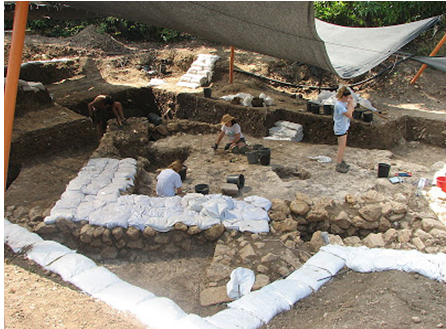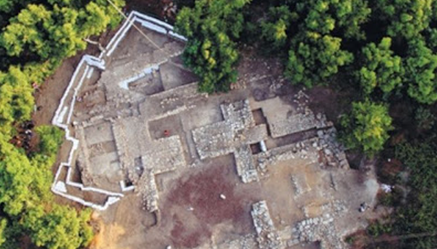Ran Shapira
Source -http://www.haaretz.com/news/national/ancient-wine-vessel-found-in-north-israel-draws-picture-of-canaanite-banquets.premium-1.483537?block=true
The Tel Kabri palace, built some 3,850 years ago and located today in Israel's north, was first discovered in the 1950s. A vessel found in one of the rooms strengthen hypothesis it was designed for special events.
|

|
|
University of of Haifa excavations at Tel-Kabri, 2011 [Credit: Wikipedia]
|
In the center of one of the rooms in the western wing of the large palace, that up to some 3,500 years ago graced the top of Tel Kabri in Israel's north, a large shard of pottery was recently discovered.
The vessel had two handles and was glazed white with red ornamentation, but it was the contents of the vessel that interested the researchers. After it was sent to the lab of Prof. Andrew Koh at Brandeis University, it was discovered to contain red wine.
By its dimensions, one could assume it contained many gallons, one of the researchers, Dr. Assaf Yasur-Landau of Haifa University said. With it, the palace's owners could serve their gests drinks at large banquets.
The wine vessels were found in a beautifully designed room in the western wing of the edifice. The floor was a yellow and white checkered design adorned by floral paintings of with irises and Colchicum. These findings, adds Dr. Yasur-Landau, strengthens the hypothesis that the room was designated for special events.
The Tel Kabri palace, located a short distance from Kibbutz Kabri, was built approximately 3,850 years ago, in the middle Bronze Age. The building held up to the elements for 300 years and at its height it sprawled over 20,000 square feet and at least two stories high. The site was discovered in 1950, and in excavations held in the 50s and 60s, the palace was revealed. About seven years ago, Dr. Yasur-Landau renewed the excaviation at the site together with Prof. Eric Cline of George Washington University.
The site was ruled by Canaanites, who developed vast commercial ties with the neighboring nations and who had a unique aesthetic taste: The palace was adorned by murals and the floor was painted in a style that was common during this period in Minoan Crete and the Aegean Sea. According to Dr. Yasur-Landau these designs are absent in other Canaanite sites in Israel.
The wine vessel that was recently found helped the researchers explain how the Canaanite rulers managed to cement their authority among their subjects and neighboring rulers. According to them, the palace was home to magnificent banquets for the local aristocracy foreign visitors, as well as, the local population.
|

|
|
The Tel-Kabri palace [Credit: Arik Klein and Assaf Yassour-Landau]
|
The researchers believe the room in which the wine vessels were found was about 1,000 square feet and was where banquets for the local aristocracy were held. Banquets, they said, were also held in other rooms.
Two other rooms were discovered along the western corridor of the palace. In one of these rooms, which apparently served as a storage space, three large jugs were found. The floor of the rooms were covered in shining white plaster, their interior walls coated in large panels of stone, in which slots for inserting additional wooden shelves had been chiseled. According to the researchers, the eloquent design of the rooms' floors and ceilings testifies to the status of the guests they would receive.
The findings were presented at a joint conference held on Sunday by the University of Haifa and the Israel Antiquities Authority, in memory of Dr. Elisha Linder and Professor Avner Raben.
The purpose of the rooms can be inferred from the animal bones found within the structure, and its entryway. Dr. Nimrod Merom, an archaeologist specializing in animal bones, determined from the remains found on the scene that the structure used to house lambs and goats.
Among the bones found was what seems to have been a wild bull's hoof, though the animal was much larger than the normal domesticated cow, remains of which were also common among the findings at the scene.
"This rare animal could supply at least 250 kilograms of meat, an amount for a 500-person feast, with each one receiving a hefty portion of 500 grams," said Dr. Merom.
"For a city that had a population of some 6,000 people, and a society that wouldn't eat meat on a daily basis, these would be saved only for special occasions, and it's safe to say that such a massive feast in the palace's courtyard would increase the ruler's political strength," added Yasur-Landau.